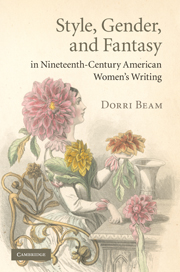Book contents
- Frontmatter
- Contents
- Acknowledgements
- Introduction. Highly wrought style
- 1 Florid fantasies: Fuller, Stephens, and the “other” language of flowers
- 2 Sensing the soul: mesmerism, feminism, and highly wrought fiction
- 3 Harriet Prescott Spofford's philosophy of composition
- 4 Pauline Hopkins' baroque folds: the styled form of Winona
- Coda: The value of ornament: Gilman and Wharton
- Notes
- Bibliography
- Index
3 - Harriet Prescott Spofford's philosophy of composition
Published online by Cambridge University Press: 05 October 2010
- Frontmatter
- Contents
- Acknowledgements
- Introduction. Highly wrought style
- 1 Florid fantasies: Fuller, Stephens, and the “other” language of flowers
- 2 Sensing the soul: mesmerism, feminism, and highly wrought fiction
- 3 Harriet Prescott Spofford's philosophy of composition
- 4 Pauline Hopkins' baroque folds: the styled form of Winona
- Coda: The value of ornament: Gilman and Wharton
- Notes
- Bibliography
- Index
Summary
The startling debut and success of writer Harriet Prescott Spofford in the first issues of the Atlantic Monthly marks an important moment in the development of women writers' interest in rendering an abundant, ornate style that challenges the existing representation of women and the feminine and offers something else in its place. Readers from Emily Dickinson to William Dean Howells were struck by what Howells called the “sumptuous and glowing fancy” of Spofford's vividly conceived stories. Anyone who has taught Spofford's widely anthologized “Circumstance,” the mythicized tale of a woman who, in the clutches of a Maine woods' panther, lulls the beast by singing all night, knows how unsatisfying it is to narrowly insist on the significance of the religious content of the songs the protagonist sings. Though Spofford uses the conversion arc of the captivity narrative to shape a story of the woman's awakening, the protagonist's expanded perception encompasses far more than God's grace as she communes with the terror and beauty of nature and comes to a new sense of self, embodied in song, upon her radical break with domesticated life. The music of her song – the notes it strikes, the melodies it holds, the aural embodiment of emotion – as much as its content, marks the birth of the new self. How her voice moves in the wilderness, as it “repeated and yet repeated, dying with long sighs of sweet sound, [and] vibrated from rock to river and back again from depth to depth of cave and cliff” and how it “soars” to the “potent sway of sound,” provides the measure of her liberation on a plane that seems uninflected by religious doctrine.
- Type
- Chapter
- Information
- Publisher: Cambridge University PressPrint publication year: 2010

